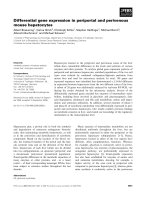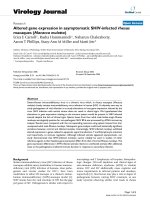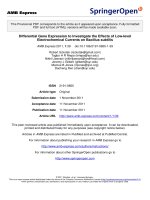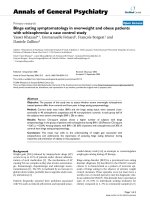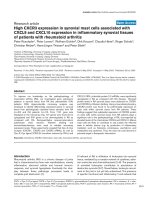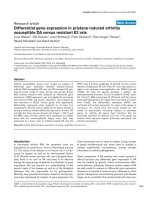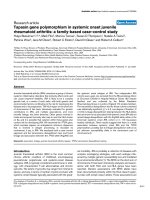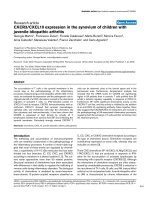Báo cáo y học: "Differential gene expression in HIV/SIV-associated and spontaneous lymphomas"
Bạn đang xem bản rút gọn của tài liệu. Xem và tải ngay bản đầy đủ của tài liệu tại đây (399.51 KB, 7 trang )
Int. J. Med. Sci. 2005 2
122
International Journal of Medical Sciences
ISSN 1449-1907 www.medsci.org 2005 2(4):122-128
©2005 Ivyspring International Publisher. All rights reserved
Research paper
Differential gene expression in HIV/SIV-associated and spontaneous lymphomas
V.V Nenasheva
1
, A.I Nikolaev
1
, AV Martynenko
1
, I.B Kaplanskaya
2
, W Bodemer
3
, G Hunsmann
4
, V.Z Tarantul
1
1. Institute of Molecular Genetics, Russian Academy of Sciences, Kurchatov sq. 2, Moscow, Russia
2. National Research Center of Hematology, Russian Academy of Medical Sciences, Novozykovskii pr. 4a, Moscow, Russia
3. Department of Infection Pathology, German Primate Center, Kelnerweg, 4, Goettingen, Germany
4. Department of Virology and Immunology, German Primate Center, Kelnerweg, 4, Goettingen, Germany
Corresponding address: Prof. V.Z. Tarantul, Deputy Director, Institute of Molecular Genetics RAS, Kurchatov Sq., 2, Moscow
123182, Russia. Phone/Fax: +7-095-196-00-02; Fax: +7-095-196-02-21;
Received: 2005.06.02; Accepted: 2005.08.29; Published: 2005.10.01
Diffuse large B-cell lymphoma (DLBCL) is more prevalent and more often fatal in HIV-infected patients and SIV-
infected monkeys compared to immune-competent individuals. Molecular, biological, and immunological data indicate
that virus-associated lymphomagenesis is similar in both infected hosts. To find genes specifically overexpressed in
HIV/SIV-associated and non-HIV/SIV-associated DLBCL we compared gene expression profiles of HIV/SIV-related
and non-HIV-related lymphomas using subtractive hybridization and Northern blot analysis. Our experimental
approach allowed us to detect two genes (a-myb and pub) upregulated solely in HIV/SIV-associated DLBCLs potentially
involved in virus-specific lymphomagenesis in human and monkey. Downregulation of the pub gene was observed in
all non-HIV-associated lymphomas investigated. In addition, we have found genes upregulated in both non-HIV- and
HIV-associated lymphomas. Among those were genes both with known (set, ND4, SMG-1) and unknown functions. In
summary, we have demonstrated that simultaneous transcriptional upregulation of at least two genes (a-myb and pub)
was specific for AIDS-associated lymphomas.
Keywords: non-Hodgkin’s lymphoma; diffuse large B-cell lymphoma, HIV/SIV-associated lymphomas; spontaneous; differentially
expressed genes; subtractive hybridization
1. INTRODUCTION
Lymphoid neoplasms represent a heterogeneous
group of malignancies including Hodgkin's disease, non-
Hodgkin lymphomas (NHLs), various leukemias, and
multiple myeloma. In recent years the molecular
mechanism of lymphomagenesis has been studied
intensively. The formation and progression of B-cell NHLs
affect 3.5-12% of patients including diffuse large B-cell
lymphomas (DLBCL) infected with the human
immunodeficiency virus (HIV) [1, 2].
In individuals with
AIDS DLBCL is 60 to 200-fold more likely to occur than in
general population [3, 4]. Infection with simian
immunodeficiency virus (SIV) in some monkeys also leads
to B-cell NHLs pathologically and clinically similar to
those of HIV-infected patients [5-8]. SIV-associated NHLs
are therefore an appropriate model to study the role of
immunodeficiency virus in lymphomagenesis.
Molecular studies have revealed both similarities
and differences between HIV-associated and non-HIV-
associated lymphomas [9-11].
Although overexpression of
some genes in a large proportion of HIV-associated
DLBCL as compared to spontaneous DLBCL has been
reported [9], specific differences in gene expression have
not yet been detected [11].
Thus the question whether
unique mechanisms leading to HIV-associated NHLs do
exist remains open.
Recently, using PCR-based two-step subtractive
hybridization we identified spectra of genes
overexpressed in human HIV-associated lymphomas [12]
and monkey SIV-associated lymphomas [13] as compared
with B-lymphocytes from blood and lymph nodes of
healthy individuals. To reveal the difference in gene
expression and to find genes both up- and down-
regulated during the formation of the lymphomas, we
performed subtractive hybridization with centroblastic
and immunoblastic HIV-associated DLBCLs in both
directions. Transcription levels of the genes overexpressed
in HIV/SIV-associated lymphomas were compared with
those in human spontaneous lymphomas. The data
obtained have revealed a specific difference in the
expression pattern of several genes in HIV/SIV-associated
as compared to non-HIV-associated (spontaneous)
DLBCLs.
2. METHODS
Tumor tissue and cells
Biopsy specimens from two lymphomas (h1 and h2)
from HIV-1-infected AIDS-patients (males, age 43 and 36,
respectively) were kindly provided by Prof. Dr. I. Schedel,
Medical School, Hannover, Germany [12]. The material
from lymphoma h1 was taken from the left tonsil. The
specimens from lymphoma h2 were taken from the liver
hilus. The latter patient was classified as WR-6 stage of
AIDS. The tumors were B-cell NHL of centroblastic type
(lymphoma h1) and immunoblastic type (lymphoma h2).
Cells from both tumors harbored Epstein-Barr virus
genomes and contained EBER-1 and EBNA-2 mRNAs
[14]. Three rhesus monkeys (M. mulatta) #1725, #7198 and
#1153 (m1, m2, and m3, respectively) developed B-NHL
after infection with SIVmac251 [13]. All samples were
examined histologically and tissue blocks were trimmed
to exclude areas of surrounding nonlymphoid tissues.
Lymphoma biopsy specimens were stored at –80°C. Using
RT-PCR, we analyzed the expression levels of the three
oncogenes (bcl-2, bcl-6 and c-myc) and two suppressor
gene (Rb и p53) both in the human and monkey AIDS-
related lymphomas. The expression profile of these genes
Int. J. Med. Sci. 2005 2
123
was similar to that found in normal human B-
lymphocytes (data not shown).
Spontaneous non-HIV-associated lymphoma biopsy
specimens were provided by the Hematology Scientific
Center of the Russian Academy of Medical Sciences. The
characteristics of these tumors are summarized in Table 1.
Human and monkey B-lymphocytes were isolated
with LymphoSep (ICN Biomedicals) from peripheral
blood of healthy donors and monkeys.
Table 1. Characteristics of human spontaneous lymphomas
##
Subtype of lymphoma
(REAL classification)
Sex/Date of
birth
#3 (# 3860-864/01) DLBCL woman/1900
#4 (# 956-998/01) FL, stage II, mixed cells woman/1945
#5 (# 3681-3682/01) FL man/1955
#7 (# 1638-1644/00) DLBCL woman/?
#8 (# 2300-1766/01) DLBCL man/1961
#9 (# 1212-1216/01) FL, stage I, preferentially small
cells
man/1936
#10 (# 1537-1539) DLBCL man/1975
#13 (# 334-336/01) Nodular sclerotic HD man/1971
#14 (# 2218-
2219/00)
Nodular sclerotic HD man/1978
DLBCL – diffuse large B-cell lymphoma; FL – follicular lymphoma; HD –
Hodgkin’s disease
RNA extraction, labeling, and hybridization
Total cellular RNA was isolated from tissues and B
lymphocytes dispersed in liquid nitrogen in the presence
of 4 M guanidine isothiocyanate as described earlier [15].
RNA was extracted twice with phenol, and its
concentration was determined spectrophotometrically.
The quality of the isolated RNA was confirmed by a
horizontal agarose gel electrophoresis as well as by OD
260/280 ratios.
Table 2. The primers structure and the annealing temperatures
used for PCR
Gene Primers Annealing, t
o
С
β-actin 5’-TGCTTCTAGGCGGACTATGAC-3’
5’-AGAAGTGGGGTGGCTTTTAGG-3’
64
set
5’-ACCTGGTTTACTGACCATTCTGA-3’
5’-TCTTCTTCACCTTCATCCTCATC-3’
59
ND4 5’-TCCCCACCTTGGCTATCATC-3’
5’-TTGTTGGCTCAGGAGTTTGA-3’
60
a-myb 5’-AAGAAGAATCAGGCACTCAACTG-3’
5’-GGAAGTGTTAGGGTTTGGTTTCT-3’
60
capn4 5’-CCACAAGCTTTTGTTCTCTCAGTA-3’
5’-CACAGGTACAGGGGAGAGGTTAC-3’
60
pub 5’-TACTGACCGAGTGCTGAGACTACT-3’
5’-GCAATTTGCCATATCAATAAAGAA-3’
60
Northern blot analysis was performed as described
earlier [12]. Membranes with RNA were UV irradiated
and hybridized with [
32
P]-labeled SalI-fragments of cDNA
clones generated by subtraction combined with
differential screening or with [
32
P]-labeled PCR-
fragments of the corresponding genes. As a control, we
used a [
32
P]-labeled
β
-actin PCR-amplification product.
The nucleotide sequences of the primers are presented in
Table 2. Dot-hybridization of the subtracted human cDNA
library with radioactively labeled monkey cDNAs was
performed as previously described [16]. cDNA and PCR-
fragments were labeled by the random-prime method
(Prime-a-Gene Labeling System, Promega, USA).
[
32
P]dCTP was obtained from Amersham International
(Amersham, UK). The radioactive bands were quantified
by Phosphorimager analysis (Molecular Dynamics, USA).
Subtractive cloning
A PCR-based technique was performed. A detailed
protocol how to generate cDNA libraries, isolation of
lymphoma-specific cDNA by subtractive hybridization
and the differential screening was published previously
[13]. In the previous study [12] we used RNAs from
lymphoma h1 and h2 cells as tracer and driver,
respectively. In this study, RNA from lymphoma h1 cells
was used as driver, and RNA from lymphoma h2 cells as
tracer.
Sequencing of DNA and analysis
Cloned cDNAs were sequenced using an Amersham
Quick-Denature-Plasmid-Sequencing Kit. A search for
similarity of the subtracted sequences with known
sequences was performed with the BLAST DataBase.
3. RESULTS
Different factors and a variety of genes may
contribute to the chain of events that eventually lead to
lymphomagenesis. In an initial study to identify genes
differentially transcribed in HIV and SIV-associated
DLBCLs we employed a two-step subtractive
hybridization using the RNA from lymphoma cells of
HIV/SIV-infected individuals as tracer and as driver the
RNA from B lymphocytes of an uninfected human and
monkey [12, 13].
However, it remained to be elucidated
whether enhanced transcription of some genes in these
lymphomas was associated with the malignant
transformation of these cells or with another factors, such
as different proliferation rates of the cell populations
examined. Another open question is whether there are
differences in the expression of genes in HIV/SIV-related
and spontaneous lymphomas.
To address these questions, the subtraction
hybridization between the two human HIV-related
lymphomas (h1 and h2) cDNAs was performed in both
directions: 1) the cDNA population of lymphoma h1 as
tracer, and the cDNA population of lymphoma h2 as
driver; and vice versa, 2) the cDNA population of
lymphoma h2 as tracer, and the cDNA population of
lymphoma h1 as driver.
The cDNAs selected by the two-step differential
screening
were sequenced and compared with nucleotide
sequences available in BLAST Databases. Partial
preliminary data concerning the first subtraction were
published [12].
The complete results of two subtractive
hybridizations in both directions are given in Table 3.
A comparison of their sequences allowed us to
subdivide the cDNAs into two groups. The first group
includes cDNAs selected both by subtractive
hybridization between the two lymphomas (Table 3) and
between lymphomas and B-lymphocytes [12] (the set
oncogene, constant part of the
λ
Ig gene, the mitochondrial
genes of NADH dehydrogenase subunit 4 (ND4), the
interferon-inducible gene 6-16 (Inf-ind), the 16S rRNA gene
(most probably the humanin gene [17]). These results
confirmed the adequacy of our method and suggested
that the use of RNA from B-lymphocytes was quite
applicable for the detection of B-cell lymphomas specific
gene expression.
Table 3. cDNA nucleotide sequences selected by two-step
hybridization and subsequent two-step differential screening of
cDNA populations from lymphoma h1 and h2 as overexpressed
Int. J. Med. Sci. 2005 2
124
both in each lymphoma in comparison with the other
lymphoma and human normal B-lymphocytes
HIV-associated
DLBCL
The differentially transcribed
genes
NCBI Acc N
set M93651
a-myb X66087
IL4R X54425
IL5 BG599356
capn4 X04106
ND4 V00662
TAP2 U07844
HnRNP A1 BG644331
16S rRNA (humanin) AY011166
IFN-ind U22970/X14583
λ
Ig X14583
γIg M63438
KIAA1536 AB040969
DKFZp547I094 AK024405
FLJ20554 AK000561
FLJ23277 AK026930
EST BG599355
EST BG599357
EST BG599358
h1
EST BG599359
SMG-1 CB252001
ribosomal protein S8 CB252002
KIAA1350 AB037771
FLJ20306 NM017756
FLJ39323 fis АК096642
FLJ14117 BC038668
FLJ30053 fis АК054615
h2
EST CB252000
capn4 – the calpain subunit 4 gene, ND4 – the NADH dehydrogenase subunit 4
gene, IL5 – the interleukin 5 gene,
λ
Ig – the
λ
-chain of immunoglobulin gene,
γIg – the γ-chain of immunoglobulin gene, IFN-ind – the interferone-inducible
gene 6-16, IL4R – the interleukin 4 receptor gene, TAP2 – the transport protein
gene, hnRNP A1 – the human ribonucleoprotein А1 gene; SMG-1 – the
phosphatidylinositol kinase (PIK)-related kinase 1 gene, EST – expressed
sequenced tags.
The second group represents those cDNAs that were
only revealed by subtractive hybridization between two
HIV-related lymphomas. In this group of upregulated
genes there were the a-myb oncogene, the interleukin 4
receptor gene (IL4R), the gene of the transporter protein
TAP2, the gene of protease calpain 4 small subunit (capn4)
and other (in case of lymphoma h1) and SMG-1, the gene
of ribosomal protein S8 (in case of lymphoma h2), as well
as several genes of unknown function (9 and 8 in the case
of lymphoma h1 and h2, respectively). The latter genes
may represent new genes associated with
lymphomagenesis but undetectable by microarray.
Differences in expression of genes of the second
group might be due to different origin and molecular
mechanisms acting in these two types of human HIV-
associated DLBCL. Perhaps the subtraction performed
would hardly shed light on the role of HIV in the
development of lymphomas, and it would be better to
subtract HIV-associated DLBCL cDNAs from those of
spontaneous DLBCL. But in earlier experiments, such a
difference was not detected [11]. We have suggested that
at least some of the genes preferentially expressed in one
of these lymphomas might be involved in HIV-associated
lymphomagenesis, and this suggestion was confirmed.
We found earlier that some genes (set, COX-II)
highly expressed in one of DLBCL, as compared to B-cells,
were actually upregulated in both HIV-associated
lymphomas [12]. The expression of several genes isolated
with subtractive hybridization between h1 and h2 (Fig 1,
see also [12]) was evaluated using Northern blot analysis
in both human lymphomas and human B-lymphocytes.
The expression of the a-myb oncogene was shown to be
higher (about 5 times) in lymphoma h1 (lane h1) than in
lymphoma h2 (lane h2), but in both cases higher (about 5-
10 times) than in human B-lymphocytes (lane B) (Fig. 1)
when normalized by
β
-actin hybridization to these filters).
Likewise, the expression levels of the SMG-1 and capn4
genes in both lymphomas were also higher (about 2-3
times) than those in normal B-lymphocytes.
Figure 1. Northern blot analysis of differential transcription in
human HIV-associated lymphomas h1 and h2, monkey SIV-
associated lymphomas m1, m2, m3, and human normal B-
lymphocytes.
32
P-labeled PCR-fragments of the a-myb oncogene
or the SMG-1 gene were hybridized to RNA from human
normal B-lymphocytes (lane B), human HIV-associated
lymphomas h1 (lane h1) and h2 (lane h2), monkey SIV-
associated lymphomas m1 (lane m1), m2 (lane m2), and m3
(lane m3). Rehybridization with a
32
P-labeled PCR-fragment of
β
-actin gene was used as control (bottom).
Macaques infected with SIV are an appropriated
animal model for HIV infection and AIDS of humans [5-8,
13]. We supposed that some genes were overexpressed
both in HIV- and SIV-associated lymphomas. Using dot
and blot hybridization, transcription of genes upregulated
in human HIV-associated lymphoma was studied in three
SIV-associated monkey lymphomas and monkey B-
lymphocytes. To this end, about 100 cDNAs from
subtracted human cDNA libraries of lymphomas h1 and
h2 were analyzed by dot blot hybridization with
[
32
P]-labeled cDNA populations from SIV-associated
monkey lymphomas and monkey B-lymphocytes. Those
cDNAs whose hybridization signals were markedly
stronger with lymphoma cDNA than with cDNA of B-
lymphocytes were further analyzed by Northern blot
hybridization. Some genes (a-myb, set, SMG-1, ND4)
involved in HIV-associated lymphomagenesis were
overexpressed in one or more SIV-associated lymphomas
(Tables 4, 5). Their transcription in other SIV-associated
lymphomas was unchanged or even downregulated. For
example, Fig. 1 shows that the transcription of the SMG-1
gene was 8 fold upregulated in lymphoma m2, unchanged
in lymphoma m3 and even downregulated (no
expression) in lymphoma m1 (lanes m1, m2, and m3). The
a-myb oncogene was about 2.5-7 fold overexpressed in all
SIV-associated monkey lymphomas (Fig. 1, lanes m1, m2,
and m3). However, the capn4 gene was not transcribed in
SIV-associated lymphomas. The results obtained were in
accord with our earlier results of Northern blot
hybridization with SIV-associated monkey mRNA [13].
Int. J. Med. Sci. 2005 2
125
Earlier we identified the pub gene as upregulated in
SIV-associated monkey DLBCL [13].
The pub gene (also
known as KIAA0129 or TRIM14) was previously found to
be expressed in the human myeloid cell line KG-1 [18].
Northern blotting with RNAs from SIV-associated
monkey lymphomas [13] demonstrated overexpression of
the pub gene in the cells of all three SIV-associated
monkey lymphomas as compared to B-lymphocytes.
Northern blot hybridization of a PCR-fragment of pub
with RNA from human HIV-associated lymphomas h1
and h2 and B-lymphocytes revealed increased levels of
this gene transcription in both these human lymphomas
(in lymphoma h1 higher than in h2) [16].
The two genes
(a-myb and pub) were thus overexpressed both in human
HIV-associated and monkey SIV-associated lymphomas
and seemed to be common for virus-specific
lymphomagenesis in human and monkey.
Table 4. Selected human HIV-associated lymphomas h1 and h2
genes overexpressed in SIV-associated monkey lymphomas in
comparison with monkey B lymphocytes (results of the blot-
and dot-hybridization)
Genes NCBI Acc N
set M93651
a-myb X66087
IL4R X54425
ND4 V00662
pub D50919
TAP2 U07844
HnRNP A1 BG644331
λ
Ig X14583
KIAA1536 AB040969
DKFZp547I094 AK024405
FLJ23277 AK026930
EST CB252000
EST CB252001
To find genes specifically overexpressed in HIV/SIV-
associated and/or non-HIV/SIV-associated DLBCLs, we
compared transcription levels of the selected genes in
HIV/SIV-associated and human non-HIV-associated
(spontaneous) lymphomas. Northern blot hybridization of
several genes with RNAs from 9 spontaneous
human lymphomas (4 - DLBCL, 3 - follicular
lymphomas (FL), 2 - Hodgkin’s disease (HD)) is
presented in Fig. 2a, 2b and Table 5.
Figure 2. Northern blot analysis of the transcription
levels of the set, ND4, and SMG-1 genes in human
spontaneous lymphomas and normal B- and T-
lymphocytes. (a)
32
P-labeled PCR-fragments of the set
and a-myb oncogenes, and ND4, pub and capn4 genes
were hybridized to RNA from human normal B-
lymphocytes (lane B), T-lymphocytes (lane T), human
spontaneous DLBCLs # 3, 7, 10 (lanes 3, 7, 10), FL # 4,
5, 9 (lanes 4, 5, 9), HD # 13, 14 (lanes 13, 14). (b) A
32
P-labeled SalG1-fragment of a cDNA clone
homologous to the SMG-1 gene was hybridized to RNA
from human normal B-lymphocytes (lane B), human
spontaneous DLBCLs # 7, 10 (lanes 7, 10), FL # 5, 9
(lanes 5, 9), HD # 13, 14 (lanes 13, 14).
Rehybridization with a
32
P-labeled PCR-fragment of
β
-
actin gene was used as control (bottom).
Table 5. Summary of gene expression levels in human non-
HIV-associated and HIV/SIV-associated lymphomas (in
comparison with normal B-lymphocytes)
The genes
upregulated only
in
virus-associated
lymphomas
The genes upregulated in
virus-associated and
spontaneous lymphomas
Lymphomas
a-myb
pub capn4 set ND4 SMG1
h1
(DLBCL)
++ + ++ ++ ++ + HIV-
associated
h2
(DLBCL)
+ + + + + ++
m1
(DLBCL)
+ ++ N + + -
m2
(DLBCL)
+++ ++ N N + ++
SIV-
associated
m3
(DLBCL)
+ + N + + +
#3
(DLBCL)
N - N + + N
#7
(DLBCL)
N - N + + +
#8
(DLBCL)
N - N + + N
#10
(DLBCL)
N - N + + -
#4 (FL) N - N + + +
#5 (FL) N - N + N +
#9 (FL) N - N N - +
#13 (HD) N - N N N +
non-HIV-
associated
#14 (HD) N - N + + N
“+”, “++” – upregulation, “-” – downregulation, “N” – no changes, DLBCL –
diffuse large B-cell lymphoma, FL – follicular lymphoma, HD – Hodgkin’s
desease, EST (NCBI Acc N CB252001)
The results indicated that the set oncogene was
transcribed 2-6 times more abundantly in several non-
HIV-associated lymphomas (as compared with normal
human B-lymphocytes) including all DLBCLs (# 3, 7, 8,
10), some FLs (# 4, 5) and HDs (# 14). The gene of the
mitochondrial NADH dehydrogenase subunit 4 (ND4)
was 2-4 times overexpressed in all analyzed spontaneous
DLBCLs (# 3, 7, 8, 10), and in some FL (# 4) and HD (# 14).
The SMG-1 gene was highly transcribed in DLBCL # 7, in
Int. J. Med. Sci. 2005 2
126
FLs # 5, 9 and in HDs # 13, 14. In lymphomas # 5 and 7
SMG-1 transcripts of different length were formed
(possible this is result of alternative splicing of mRNA).
However, Northern blot analysis revealed no
transcription of the a-myb and capn4 genes in non-HIV-
associated lymphomas and B-lymphocytes (Fig. 2a). The
pub gene was slightly transcribed in B-lymphocytes and
not transcribed in all non-HIV-associated lymphomas
(Fig. 2a).
Thus, three genes (a-myb, pub, capn4) are upregulated
exclusively in HIV-associated DLBCLs and probably
specific for these lymphomas. Two of them (a-myb, pub)
were found upregulated also in SIV-associated DLBCLs.
The pub gene was downregulated in all non-HIV-
associated lymphomas analyzed. Also, we revealed a set
of genes (set, ND4, SMG-1) which upregulated both in
non-HIV-associated and in HIV/SIV-associated
lymphomas.
4. DISCUSSION
Our studies were aimed at the detection of new
genes involved in the process of lymphomagenesis.
Numerous approaches have been proposed to identify
and analyze genes differentially expressed in cancer cells
and particularly in lymphomas [9, 11-13, 19-22]. These
techniques allowed to detect sets of genes up- or
downregulated in malignant cells used as diagnostic
markers to characterize different types of lymphomas. The
cDNA microarray technology [19-22] has allowed the
investigation of global gene expression profiles in cancer.
Although cDNA microarray is a powerful tool for the
identification of differentially expressed genes, this
methodology has several potential limitations [22].
To identify genes differentially expressed in
HIV/SIV-associated lymphomas, we used the PCR-based
two-step subtractive hybridization.
This method does not
need any previously cloned cDNA sets and allows to
detect unknown genes. However, it remained to be
elucidated whether enhanced transcription of some genes
in lymphomas detected by this approach was associated
with malignant transformation or with other factors, e.g.
different proliferation rates of the cell populations
examined. To answer this question, we performed
subtractive hybridization between DLBCLs from two
different AIDS-patients. The results of several
independent experiments demonstrated that many of the
genes revealed by us previously were also upregulated in
the two lymphoma types. In HIV-associated lymphomas
h1 and h2, some upregulated cDNA clones were found to
be homologous to known genes including the set and a-
myb oncogenes, genes of ND4, IL4R, IL5, SMG-1,
ribosomal protein S8, immunoglobulins,
ribonucleoprotein hnRNP A1, transport protein ТАР2,
CAPN4, etc. In addition, 17 overexpressed clones
homologous to expressed sequence tags (ESTs) were
detected. They may represent novel genes whose
transcription is upregulated in lymphomas. A number of
the genes detected in these experiments have not been
previously associated with DLBCL of different origin.
A comparison of expression profiles of some of these
genes with those for the genes revealed earlier by
subtractive hybridization in SIV-associated lymphomas
[13] were very similar (Tables 4 and 5). About 10 genes
were found to be overexpressed both in HIV- and SIV-
related lymphomas.
To find genes specific for HIV/SIV-associated
and/or non-HIV/SIV-associated DLBCLs, we examined
the expression levels of these 10 upregulated genes in
spontaneous lymphomas. The results obtained (Table 5)
allowed us to subdivide these genes into two groups.
Firstly, we detected three genes (a-myb, pub, capn4)
upregulated exclusively in human HIV-associated
DLBCLs (and not in spontaneous lymphomas) and
apparently specific for these DLBCLs. Transcription levels
of the lymphoma-specific genes in three SIV-associated
DLBCLs showed that two genes (a-myb, pub) of this group
were overexpressed also in SIV-associated DLBCLs and
might be involved in virus-specific lymphomagenesis in
human and monkey. Secondly, the transcription of set,
ND4, SMG-1 was increased in most HIV- and non-HIV-
associated lymphomas. These genes may be involved in
both HIV-associated and non-HIV-associated
lymphomagenesis. Some genes of this group (set, SMG-1,
ND4) were overexpressed at least in one SIV-associated
lymphoma, in the other SIV-associated lymphomas
investigated their expression was unchanged or even
downregulated.
Moreover, we compared the expression of the
selected lymphoma specific genes in normal human
T-lymphocytes and the Jurkat T-cell line. Expression of set,
SMG-1, and ND4 was unchanged, and pub and a-myb were
not transcribed in normal human T-lymphocytes and the
Jurkat cells (data not shown). These results suggested an
association of the former genes exclusively with B cell but
not T cell lymphomas.
Attempts to reveal genes overexpressed in HIV-
related DLBCL versus DLBCL have already been reported
[9, 11]. Preliminary evidence for the high and specific
expression of the TCL-1 proto-oncogene in HIV-related
lymphomas [9] was confirmed only partially [11]. In
contrast to our data, genes specifically expressed in AIDS-
related lymphomas were not detected. This contradiction
is most likely explained by technical differences. For
example, Patrone et al. [11] arbitrarily excluded some
apparently “uninteresting” genes. But we have shown
earlier that genes like ATP synthase, cytochrome b,
cytochrome c oxidase, and 16S rRNA are specifically
upregulated in lymphomas [12, 13]. Also, the gene named
16S RNA most probably relates to the humanin gene [17],
since its transcript contains poly(A).
According to our data (Tab. 5) a-myb was
overexpressed in all AIDS-related lymphomas. At the
same time, transcription of a-myb is unchanged or even
reduced in all non-AIDS-related lymphomas analyzed
here. a-myb overexpressed in many cancer cells and in
several germinal center (GC) B-like DLBCL [19, 23].
Among the other genes (bcl-6, bcl-7A) the a-myb defined
subtype GC B-like DLBCL but it was not a general rule.
The a-myb product is known to upregulate bcl-2 in various
lymphomas and to maintain the expression of c-myc in
mouse B cell lymphoma [24]. Both these gene upregulated
mainly in subtype activated B-like DLBCL [19]. Using RT-
PCR, we analyzed the expression levels of the three
oncogenes (bcl-2, bcl-6 and c-myc) both in the human and
monkey AIDS-related lymphomas. The expression profile
of these genes was similar to that found in normal human
B-lymphocytes. This suggested that AIDS-related
lymphomas have been hardly referred to any definite
subtype of DLBCL.
Some of the genes we identified have not been
implicated previously in DLBCL. According to our data


